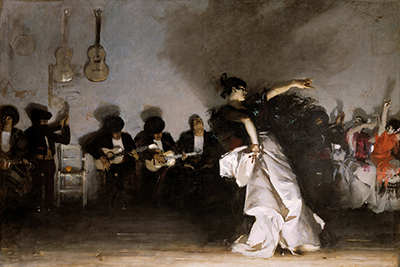El Jaleo by John Singer Sargent is currently housed in the Isabela Gardner Museum in Boston, Massachusetts
Occupying a vast space more than 7 by 11½ feet, it covers the end of a long, dark hallway - the ideal location. El Jaleo means "a solo dancer with castanets".
Origins of the Art
Spanish Gypsies, Flamenco and El Jaleo – the stories intertwine. In 1879 when Paris was shocked by the death of a famous exotic Gypsy, Carmen, Sargent left for Spain.
Though labelled as an American artist, Sargant was born in Florence. He was mesmorized by the Gypsies and their ability to break into song and dance in an instance. The exotic Hispanic dancers captured his attention.
Like the American Blues, the origins of Flamenco came from oppression, sung by lonely male voices. The music expanded to include sticks used as percussion, guitars and dancers. And in El Jaleo, the use of castanets.
Flamenco dancers by the mid 1800s were being booked for performances in nightclubs all over Spain. As the dance became more commercialised, Sargent in his painting, was determined to capture the original spirit of Flamenco which was one of melancholy yet celebratory in its own way.
The Start of El Jaleo
Sargent commenced on his sketches in 1879 when the exotic dance and music mesmerized him. He was at that time studying the paintings of Velaquez who influences his painting techniques used in El Jaleo. He was so passionate and in love with the music that he believed that all music stemmed from Spanish music. He loved it and he breathed it.
After hearing it played in the nightclubs, he transferred his sketches to a sketchpad. He did nothing with the sketches for another three years before he finally took on models to depict the scene. None of the models were either Hispanic nor Gypsies.
But the scene was so etched in his mind that the accuracy of the drawings were perfect. With his love for the soulful Flamenco, Sargant transposed his sketches onto canvas.
Analysis of El Jaleo
An astute artist analysing his work would say that the painting was done as if it was "cooked by a chef" as more and more "ingredients" were added on to the art as he painted it.
It seemed like he kept throwing more paint to make the shadows more dramatic and realised it wasn't enough and did it again. Just like a chef to tastes his food and adds more spice to the mix.
Composition
The stage is set as in a traditional Hispanic/Spanish setting – something Sargant had a passion for. The picture depicts a Gypsie dancing with the accompaniment of several musicians. The guitars were atypical of the Gypsies. As the name suggests, there were castanets.
The crowded stage with musicians on the left and the dancer herself slightly off centre to the right gives the painting asymmetry. The empty chair on stage implies that it was her seat as she is the only standing person in the room. Her feet is so close to the edge of the canvas that it indicates an intimate setting.
Colour
The monochromatic colour scheme – black, gray and white. The small touches of red show the typical costume of Flamenco dancers and it adds some life to the monochromatic tones. The red is used very sparsely but symmetrically.
Lighting
Before the times of electricity, candles were used to light up theatres at night. The dancer is illuminated by the swirling lights from the candles. The dark shadows from her arms giving the dramatic effect of movement. Her skirt is lit up by the candles giving it a sheen look.
Strokes
Sargent uses loose and free strokes for the canvas and he left it unvarnished to make it more vibrant. The loose and free strokes have a similarity to the paintings of Velaqquez.
The mood of the painting is one of sadness, yet of celebration.
The Inspiration
Spain was the major inspiration for El Jaleo. Gypsies, Hispanic and exotic females mixed with Flamenco music and rhythm were all influencers of the art. However, Sargant was inspired by the artwork of some of these artists that he studied:
Diego Velazquez: Velazquez was the main reason Sargant went to Spain in the first instance – to study his art and techniques. The main technique used here from Velaquez was the lack of under-drawing and under-painting. Instead, just painting directly onto the canvas.
Francisco de Goya: Francisco de Goya was well known for his dramatic use of light and shadows in his painting. He was also great in capturing emotional events as he did in the Peninsular War. Sargent used these techniques in El Jaleo. See also Third of May.
In Summary
El Jaleo is a beautiful piece of art depicting the lives of the nomadic gypsies who had their special place in Spain.




